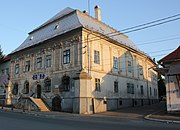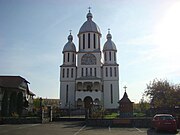Baia Sprie
Baia Sprie | |
|---|---|
 | |
 Location in Maramureș County | |
| Coordinates: 47°39′33″N 23°42′15″E / 47.65917°N 23.70417°E | |
| Country | Romania |
| County | Maramureș |
| Government | |
| • Mayor (2020–2024) | Sebastian Alin Bîrda[1] (PNL) |
| Area | 96 km2 (37 sq mi) |
| Elevation | 500 m (1,600 ft) |
| Population (2021-12-01)[2] | 14,329 |
| • Density | 150/km2 (390/sq mi) |
| Time zone | EET/EEST (UTC+2/+3) |
| Postal code | 435100 |
| Area code | (+40) 02 62 |
| Vehicle reg. | MM |
| Website | www |
Baia Sprie (Romanian pronunciation: [ˌbaja ˈspri.e] ⓘ; Hungarian: Felsőbánya, German: Mittelstadt) is a town in Maramureș County, northern Romania. Baia Sprie is situated at a distance of 9 km (5.6 mi) from Baia Mare and belongs to the Baia Mare metropolitan area.
The town administers three villages: Chiuzbaia (Kisbánya), Satu Nou de Sus (Felsőújfalu), and Tăuții de Sus (Giródtótfalu). Neighbouring communities are the city of Baia Mare and the communes Groși, Dumbrăvița, Șisești, and Desești.
The town was one of the most important mining centers in north-western Romania, exploitation of gold and silver being mentioned in documents written in the Middle Ages, during the time when the Saxons colonized the region. However, recent administrative changes and restructuring of the Romanian mining industry brought this activity to an almost complete halt.
History
The first written mention of the settlement dates back to 1329 as "Civitas in medio monte", in 1406 as "civitas Medii Montis", in 1390, 1452, 1455 as "civitas Felsevbanya", and since 1523 as Felsőbánya. The old Romanian name of the town was Baia de Sus, which means "Upper Mine", same as in Hungarian.
The town was in Szatmár County, in the Kingdom of Hungary. King Sigismund, Holy Roman Emperor, as part of treaty with Serbian ruler Despotus Stefan Lazarević, gave him Baia Sprie as a gift in 1411, until Lazarević' death in 1427. A year later, Lazarević's successor, Despotus Đurađ Branković of Serbia, became lord of Baia Sprie. In 1567, Baia Sprie was annexed by János Zsigmond, Prince of Transylvania. In 1605–1606, 1621–1629, and 1645–1648, the town and the county were part of the Principality of Transylvania.
The 1850 census, conducted in
After the collapse of
Population
| Year | Pop. | ±% |
|---|---|---|
| 1880 | 6,881 | — |
| 1900 | 6,813 | −1.0% |
| 1910 | 4,422 | −35.1% |
| 1930 | 4,127 | −6.7% |
| 1941 | 7,167 | +73.7% |
| 1948 | 3,968 | −44.6% |
| 1956 | 8,134 | +105.0% |
| 1966 | 13,182 | +62.1% |
| 1977 | 15,554 | +18.0% |
| 1992 | 16,059 | +3.2% |
| 2002 | 15,735 | −2.0% |
| 2011 | 14,971 | −4.9% |
| 2021 | 14,329 | −4.3% |
| Source: Census data | ||
At the
References
- ^ "Results of the 2020 local elections". Central Electoral Bureau. Retrieved 14 June 2021.
- ^ "Populaţia rezidentă după grupa de vârstă, pe județe și municipii, orașe, comune, la 1 decembrie 2021" (XLS). National Institute of Statistics.
- ^ "Populația rezidentă după grupa de vârstă, pe județe și municipii, orașe, comune, la 1 decembrie 2021" (in Romanian). INSSE. 31 May 2023.
External links
- Photos of the town and its surroundings in the dedicated Flickr group







